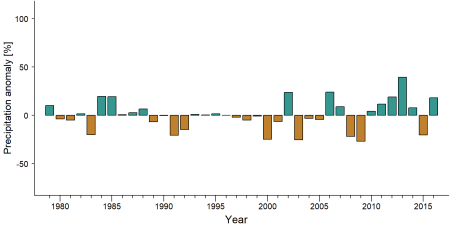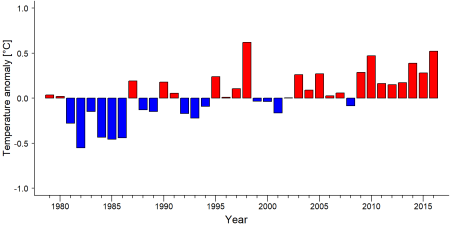Difference between revisions of "Zone Humide d'Ebogo"
| (2 intermediate revisions by the same user not shown) | |||
| Line 299: | Line 299: | ||
| | | | ||
|'''1981-2010''' | |'''1981-2010''' | ||
| − | |'''2021-2050 | + | |'''2021-2050, RCP 2.6''' |
| − | |'''2021-2050 | + | |'''2021-2050, RCP 6.0''' |
| − | |'''2071-2099 | + | |'''2071-2099, RCP 2.6''' |
| − | |'''2071-2099 | + | |'''2071-2099, RCP 6.0''' |
|- | |- | ||
|Mean temperature [°C] | |Mean temperature [°C] | ||
| Line 338: | Line 338: | ||
{| border='1' cellpadding='5' cellspacing='0' class='EE-table' | {| border='1' cellpadding='5' cellspacing='0' class='EE-table' | ||
| | | | ||
| − | |'''No. of years with event (2021-2050 | + | |'''No. of years with event (2021-2050, RCP 2.6)''' |
| − | |'''% of site exposed (2021-2050 | + | |'''% of site exposed (2021-2050, RCP 2.6)''' |
| − | |'''No. of years with event (2021-2050 | + | |'''No. of years with event (2021-2050, RCP 6.0)''' |
| − | |'''% of site exposed (2021-2050 | + | |'''% of site exposed (2021-2050, RCP 6.0)''' |
| − | |'''No. of years with event (2070-2099 | + | |'''No. of years with event (2070-2099, RCP 2.6)''' |
| − | |'''% of site exposed (2070-2099 | + | |'''% of site exposed (2070-2099, RCP 2.6)''' |
| − | |'''No. of years with event (2070-2099 | + | |'''No. of years with event (2070-2099, RCP 6.0)''' |
| − | |'''% of site exposed (2070-2099 | + | |'''% of site exposed (2070-2099, RCP 6.0)''' |
|- | |- | ||
|Crop failure | |Crop failure | ||
| Line 408: | Line 408: | ||
|- | |- | ||
|} | |} | ||
| + | |||
<div><ul> | <div><ul> | ||
Latest revision as of 04:23, 1 June 2023
Central Africa > Cameroon > Zone Humide d'Ebogo
Summary
- Central chimpanzees (Pan troglodytes troglodytes) and western lowland gorillas (Gorilla gorilla gorilla) are present in Zone Humide d'Ebogo.
- The population sizes are unknown.
- The population trends are unknown.
- The site has a total size of 30.97 km².
- Forest loss and forest degradation due to wood harvesting, agriculture and collection of non-timber forest products are some of the known threats in the site.
- Conservation activities are unknown.
- The site was designated a Ramsar site in 2012.
Site characteristics
The site is located about 40 km south of Yaoundé, the capital city of Cameroon. The area supports several IUCN Red-Listed plant species including the African Pearwood (Baillonella toxisperma), Sapele (Entandrophragma cylindricum) and Ebony (Diospyros crassiflora). It also supports nationally important animal species such as the Nile Monitor (Varanus niloticus) and the African Python (Python sebae) as well as over 100 waterbird species. The temporarily flooded marshes serve as food and breeding ground for waterbirds. It was designated as a Ramsar site in 2012. The forest also supports a rich diversity of non-timber forest products important to the local population both as a source of food and as a cultural heritage (Ramsar 2012). The area is surrounded by the Mbalyamo Forest Reserve.
Table 1. Basic site information for Zone Humide d'Ebogo
| Area | 30.97 km² |
| Coordinates | 3.393683, 11.483002 |
| Designation | Forest Reserve |
| Habitat types | Subtropical/tropical swamp forest |
IUCN habitat categories Site designations
Ape status
Table 2. Ape population estimates in Zone Humide d'Ebogo
| Species | Year | Abundance estimate (95% CI) | Density estimate [ind./ km²] (95% CI) | Encounter rate (nests/km) | Area | Method | Source | Comments | A.P.E.S. database ID |
|---|---|---|---|---|---|---|---|---|---|
| Pan troglodytes troglodytes | Zone Humide d'Ebogo | ||||||||
| Gorilla gorilla gorilla | Zone Humide d'Ebogo |
Threats
Table 3. Threats to apes in Zone Humide d'Ebogo
| Category | Specific threats | Threat level | Quantified severity | Description | Year of threat |
|---|---|---|---|---|---|
| 1. Residential & commercial development | 1.1 Housing & urban areas | Low | Built areas around the eastern and western boundaries of the site (Liliane et al. 2022). | Ongoing (2022) | |
| 2. Agriculture & aquaculture | 2.1 Annual & perennial non-timber crops | High | Agriculture is a major cause of forest degradation in and around the site (Liliane et al. 2022). | Ongoing (2022) | |
| 3. Energy production & mining | Unknown | ||||
| 4. Transportation & service corridors | Unknown | ||||
| 5. Biological resource use | 5.2 Gathering terrestrial plants | High | Collection of NFTPs for food and medicine (Liliane et al. 2022). | Ongoing (2022) | |
| 5.3 Logging & wood harvesting | High | Wood harvesting (Liliane et al. 2022). | Ongoing (2022) | ||
| 6. Human intrusion & disturbance | Unknown | ||||
| 7. Natural system modifications | Unknown | ||||
| 8. Invasive & other problematic species, genes, diseases | Unknown | ||||
| 9. Pollution | Unknown | ||||
| 10. Geological Events | Absent | ||||
| 11. Climate change & severe weather | Unknown | ||||
| 12. Other options | Absent |
Conservation activities
Table 4. Conservation activities in Zone Humide d'Ebogo
| Category | Specific activity | Description | Year of activity |
|---|---|---|---|
| 1. Residential & commercial development | Not reported | ||
| 2. Agriculture & aquaculture | Not reported | ||
| 3. Energy production & mining | Not reported | ||
| 4. Transportation & service corridors | Not reported | ||
| 5. Biological resource use | Not reported | ||
| 6. Human intrusion & disturbance | Not reported | ||
| 7. Natural system modifications | Not reported | ||
| 8. Invasive & other problematic species, genes, diseases | Not reported | ||
| 9. Pollution | Not reported | ||
| 10. Education & Awareness | Not reported | ||
| 11. Habitat Protection | 11.2. Legally protect primate habitat | The site is protected internationally as a Ramsar site since 2012, but the management plan and national authority for the site are unknown (UNEP-WCMC 2023). | Ongoing (2023) |
| 12. Species Management | Not reported | ||
| 13. Livelihood; Economic & Other Incentives | Not reported |
Conservation activities list (Junker et al. 2017)
Challenges
Table 5. Challenges reported for Zone Humide d'Ebogo
| Challenge | Source |
|---|---|
| Not reported |
Research activities
Documented behaviours
Table 6. Ape behaviors reported for Zone Humide d'Ebogo
| Behavior | Source |
|---|---|
| Not reported |
Exposure to climate change impacts
As part of a study on the exposure of African great ape sites to climate change impacts, Kiribou et al. subm. extracted climate data and data on projected extreme climate impact events for the site. Climatological characteristics were derived from observation-based climate data provided by the Inter-Sectoral Impact Model Intercomparison Project (ISIMIP, www.isimip.org). Parameters were calculated as the average across each 30-year period. For 1981-2010, the EWEMBI dataset from ISIMIP2a was used. For the two future periods (2021-2050 and 2071-2099) ISIMIP2b climate data based on four CMIP5 global climate models were used. For future projections, two Representative Concentration Pathways (RCP) were used. RCP 2.6 is a scenario with strong mitigation measures in which global temperatures would likely rise below 2°C. RCP 6.0 is a scenario with medium emissions in which global temperatures would likely rise up to 3°C by 2100. For the number of days with heavy precipitation events, the 98th percentile of all precipitation days (>1mm/d) was calculated for the 1979-2013 reference period as a threshold for a heavy precipitation event. Then, for each year, the number of days above that threshold was derived. The figures on temperature and precipitation anomaly show the deviation from the mean temperature and mean precipitation for the 1979-2013 reference period. The estimated exposure to future extreme climate impact events (crop failure, drought, river flood, wildfire, tropical cyclone, and heatwave) is based on a published dataset by Lange et al. 2020 derived from ISIMIP2b data. The same global climate models and RCPs as described above were used. Within each 30-year period, the number of years with an extreme event and the average proportion of the site affected were calculated (see Kiribou et al. subm. for details).
Table 7. Estimated past and projected climatological characteristics in Zone Humide d'Ebogo
| 1981-2010 | 2021-2050, RCP 2.6 | 2021-2050, RCP 6.0 | 2071-2099, RCP 2.6 | 2071-2099, RCP 6.0 | |
| Mean temperature [°C] | 23.8 | 25 | 24.9 | 25.2 | 26.2 |
| Annual precipitation [mm] | 2228 | 2308 | 2326 | 2389 | 2375 |
| Max no. consecutive dry days (per year) | 28.6 | 17.3 | 18.5 | 15.3 | 21.4 |
| No. days with heavy precipitation (per year) | 6 | 7.8 | 8.1 | 8.5 | 9.5 |
Table 8. Projected exposure of apes to extreme climate impact events in Zone Humide d'Ebogo
| No. of years with event (2021-2050, RCP 2.6) | % of site exposed (2021-2050, RCP 2.6) | No. of years with event (2021-2050, RCP 6.0) | % of site exposed (2021-2050, RCP 6.0) | No. of years with event (2070-2099, RCP 2.6) | % of site exposed (2070-2099, RCP 2.6) | No. of years with event (2070-2099, RCP 6.0) | % of site exposed (2070-2099, RCP 6.0) | |
| Crop failure | 7 | 1.3 | 4.5 | 1.28 | 4.5 | 0.78 | 16.5 | 0.96 |
| Drought | 0 | 0 | 0 | 0 | 0 | 0 | 0 | 0 |
| Heatwave | 0 | 0 | 0.5 | 50 | 2.5 | 100 | 2 | 100 |
| River flood | 1 | 0.35 | 2 | 4.69 | 0.5 | 2.76 | 3 | 0.84 |
| Tropical cyclone | 0 | 0 | 0 | 0 | 0 | 0 | 0 | 0 |
| Wildfire | 30 | 0.27 | 30 | 0.3 | 29 | 0.28 | 29 | 0.33 |
External links
References
Kiribou, R., Tehoda, P., Chukwu, O., Bempah, G., Kühl, H.S., Ferreira, J., Sop, T., Carvalho, J., Mengel, M., Heinicke, S. (subm) Exposure of African ape sites to climate change impacts.
Liliane, M. D., Romain, N. J., Caroline, M. S. M., Abigaelle, T., & Loic, T. T. A. (2022). Quantifying Forest Loss in the Mbalmayo Forest Reserve (Center Region, Cameroon). Journal of Geoscience and Environment Protection, 10(9), 271-288.
Ramsar (2012. Zone Humide d'Ebogo. Online: https://rsis.ramsar.org/fr/ris/2068
UNEP-WCMC (2023). Protected Area Profile for Zone Humide d'Ebogo from the World Database on Protected Areas, May 2023. Available at: www.protectedplanet.net
Page completed by: A.P.E.S. Wiki team Date: 26/05/2023

